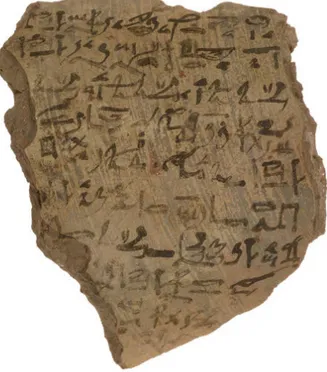Tracking the writings of a 19
thdynasty scribe.
The ‘messy polygraph’ from Deir el-Medina
Stéphane POLIS (F.R.S.-FNRS)
When he published the prayer to ‘Amun, judge of the poor’ (O. IFAO inv. 2181 = Fig. 1), Posener (1971) pointed to a couple of related prayers to Amun on ostraca, which share striking palaeographical features with this text (O. Borchardt s.n. and O. Gardiner 45). Resorting to the methodology developed by van den Berg & Donker van Heel (2000), namely taking into account the provenance of this prayer to Amun (which is known as ‘Maison G’), one can identify additional texts written by the same hand, esp. in the unpublished literary material of the IFAO (O. IFAO OL 4219a-c, O. IFAO OL 4224, O. IFAO OL 4225, O. IFAO OL 5684).
Fig. 1. O. IFAO inv. 2181
In a second step, using lexicographical and phrasaeological criteria (Donker van Heel & Haring 2003) as well as specific palaeographical features (Janssen 1987; Sweeney 1998; Hudson 2018) and habits in terms of layout (Gasse 1992), additional ostraca from the Theban necropolis with the same handwriting can be identified in the published material, such as O. DeM 1055 (Posener 1938), O. DeM 10249 (Grandet 2017), O. Gurna 647 (Burkard 2001: 5–10).
The goal of this lecture will be (a) to present the variety of texts produced by this hieratic hand during the 19th dynasty (see the case of Amennakhte (v) for the 20th dynasty; see recently Dorn 2015 and Polis 2018), (b) to show that the traditional division between ‘literary’ and ‘non-literary’ hands does not apply (since the scribe’s handwriting does not vary much according to genres), and (c) to try and identify the individual behind this hand, so as to enrich to list of scribes, such as Ramose or Qenherkhopshef, who can be recognized based on their idiosyncratic handwriting.
References
BERG, Hans VAN DEN & Koen DONKER VAN HEEL. 2000. A scribe's cache from the Valley of Queens? The palaeography of documents from Deir el-Medina: some remarks. In Demarée, R.J. and A. Egberts (eds), Deir el-Medina in the third millennium AD: a tribute
to Jac. J. Janssen, 9-49. Leiden: Nederlands Instituut voor het Nabije Oosten.
BURKARD, Günter. 2001. Einige Briefe aus Deir el Medine. Göttinger Miszellen 185, 5-21.
DONKER VAN HEEL, Koenraad & Ben J.J. HARING. 2003. Writing in a workmen’s village: scribal
practice in Ramesside Deir el-Medina. Egyptologische Uitgaven 16. Leiden: Nederlands
Instituut voor het Nabije Oosten.
DORN, Andreas 2015. Diachrone Veränderungen der Handschrift des Nekropolenschreibers Amun-nacht, Sohn des Ipui. In VERHOEVEN, Ursula (ed.), Ägyptologische “Binsen”-Weisheiten
I-II: Neue Forschungen und Methoden der Hieratistik. Akten zweier Tagungen in Mainz im April 2011 und März 2013, 175-218. Stuttgart: Franz Steiner.
GASSE, Annie. 1992. Les ostraca hiératiques littéraires de Deir el-Medina : nouvelles orientations de la publication. In Demarée, R.J. and A. Egberts (eds), Village voices: Proceedings of the
symposium ‘Texts from Deir el-Medîna and their interpretation,’ Leiden, May 31 - June 1, 1991, 51-70. Leiden: Centre of Non-Western Studies, Leiden University.
JANSSEN, Jac. J. 1987. On style in Egyptian handwriting. Journal of Egyptian Archaeology 73, 161-167.
GRANDET, Pierre. 2017. Catalogue des ostraca hiératiques non littéraires de Deir el-Médînéh. Tome
XII : nos 10276-10405. Documents de fouilles de l’Institut français d’archéologie
orientale 50. Le Caire: Institut français d'archéologie orientale.
MCCLAIN, Stephanie E. 2018. Authorship and attribution: who wrote the Twentieth Dynasty Journal of the Necropolis? In Dorn, Andreas and Stéphane Polis (eds), Outside the box: selected
papers from the conference “Deir el-Medina and the Theban Necropolis in Contact” Liège, 27–29 October 2014 , 333-364. Liège: Presses Universitaires de Liège.
POLIS, Stéphane 2018. The scribal repertoire of Amennakhte son of Ipuy: describing variation across Late Egyptian registers. In Cromwell, Jennifer and Eitan Grossman (eds), Scribal
repertoires in Egypt from the New Kingdom to the early Islamic period, 89-126. Oxford:
Oxford University Press.
POSENER, Georges. 1938. Catalogue des ostraca hiératiques littéraires de Deir el Médineh, I (nos
1001 à 1108). Documents de fouilles de l’Institut français d’archéologie orientale 1. Le
Caire: Institut français d'archéologie orientale.
————. 1971. Amon juge du pauvre. In Haeny, Gerhard (ed.), Aufsätze zum 70. Geburtstag von
Herbert Ricke, 59-63. Wiesbaden: Franz Steiner.
SWEENEY, Deborah 1998. Friendship and frustration: a study in papyri Deir el-Medina IV-VI. Journal
